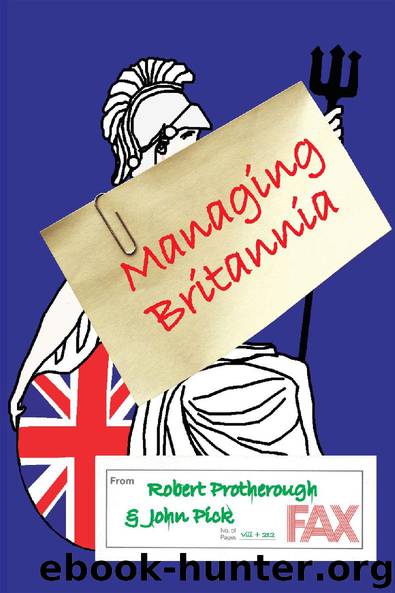Managing Britannia by Robert Protherough & John Pick

Author:Robert Protherough & John Pick
Language: eng
Format: epub
Tags: Management, higher education, managers, strategy, outcomes, modern management, management science, politics, education, culture, religion, national malaise
ISBN: 9781845404796
Publisher: Andrews UK Limited 2016
Published: 2016-07-05T00:00:00+00:00
This unit is of course no worse than dozens of others, and (for one cannot know what criteria are now used to determine “world-class centres of excellence” in the “creative industries”) one day it may achieve its chosen managerial objectives. We merely observe that this ambitious little bureaucracy, proselytising for the new Ministry’s top-down support systems, preaching the virtues of modern management, yet operates within shouting distance of one of the most public failures of the whole “creative industries” frenzy. Sheffield’s National Centre for Popular Music had impeccable credentials - heavily funded by the state lottery, its management and marketing put in place by some of the best-paid consultants in the industry - but it has not been, to put it politely, an outstanding success. [10]
It would of course be unfair even to mention this, still less to draw from it any conclusions, were it not generally the case that Britain’s new cultural managers constantly tell us that everything is in fact going extremely well. Let us briefly glance by way of illustration at one of the most visible of the state-managed cultural institutions, the Royal Opera House. Its renovation has been the largest of the lottery-funded projects, with a capital grant of more than £60 million. Its reopening in late 1999, in greatly enlarged premises, was under a new American executive director. This event followed upon a year’s closure (during which, uniquely, the company had retained its full Arts Council grant-in-aid for giving performances). The Minister had taken a close personal interest both in the restructuring of the management and in the House’s new philosophy. It was to open on time, within budget, and henceforth to be known as the “People’s Opera House”. The one managerial target that was clearly met was that the rebuilt opera house did open on time - though with a platform performance of opera highlights and an understandably cautious performance by the dance company (much of the backstage equipment was not ready for operation). But it was already £7 million over budget. Worse was to follow, as the technical difficulties meant that in the first month no fewer than twelve performances were cancelled. And there was no sign that it had been transformed into a “People’s Opera House”. Indeed the reopening night was one of the most starry events that fashionable London had seen for some time, black-tie save for the Minister, who reputedly salved his political conscience by wearing a dark red bow. The management then received a barrage of complaints from those who had paid heavily for seats from which there was a poor view, followed by another wave of complaints from those who wished to wander through its state-financed foyers, but frequently found them closed off for “corporate events”.
None of which would have been out of the way - newly-built theatres and opera houses notoriously have technical problems, after all - were it not for the manic desire of the cultural spin-doctors to pretend that all was well. “Let’s dream again,”
Download
This site does not store any files on its server. We only index and link to content provided by other sites. Please contact the content providers to delete copyright contents if any and email us, we'll remove relevant links or contents immediately.
Hit Refresh by Satya Nadella(9038)
The Compound Effect by Darren Hardy(8808)
Change Your Questions, Change Your Life by Marilee Adams(7634)
Nudge - Improving Decisions about Health, Wealth, and Happiness by Thaler Sunstein(7615)
The Black Swan by Nassim Nicholas Taleb(7010)
Deep Work by Cal Newport(6878)
Daring Greatly by Brene Brown(6444)
Rich Dad Poor Dad by Robert T. Kiyosaki(6401)
Principles: Life and Work by Ray Dalio(6208)
Man-made Catastrophes and Risk Information Concealment by Dmitry Chernov & Didier Sornette(5921)
Playing to Win_ How Strategy Really Works by A.G. Lafley & Roger L. Martin(5916)
Digital Minimalism by Cal Newport;(5663)
Big Magic: Creative Living Beyond Fear by Elizabeth Gilbert(5610)
The Myth of the Strong Leader by Archie Brown(5424)
The Slight Edge by Jeff Olson(5346)
Discipline Equals Freedom by Jocko Willink(5284)
The Motivation Myth by Jeff Haden(5155)
Stone's Rules by Roger Stone(5026)
The Laws of Human Nature by Robert Greene(4996)
